air condition LEXUS RC350 2021 Owners Manual
[x] Cancel search | Manufacturer: LEXUS, Model Year: 2021, Model line: RC350, Model: LEXUS RC350 2021Pages: 400, PDF Size: 7.9 MB
Page 1 of 400
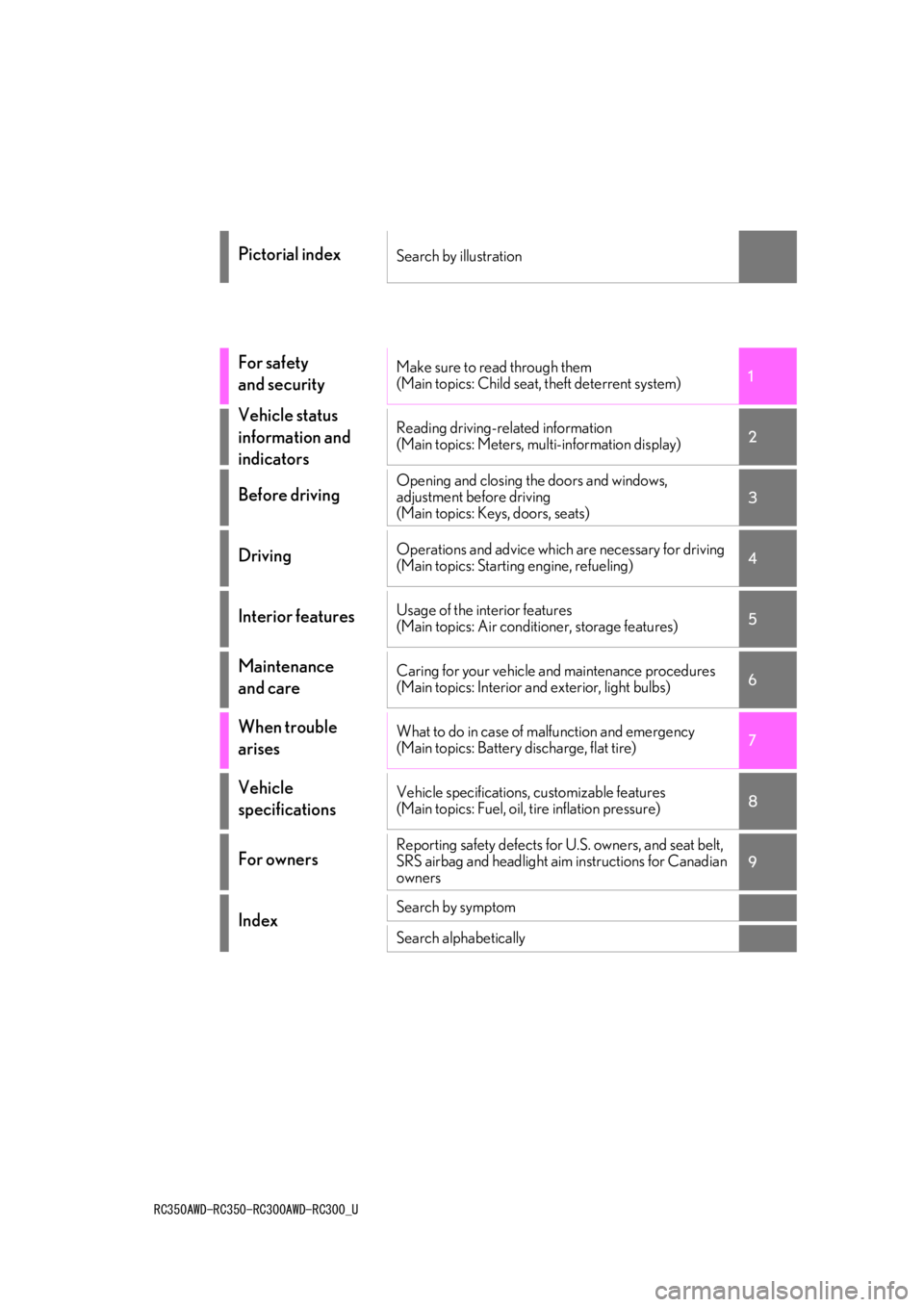
RC350AWD-RC350-RC300AWD-RC300_U
1
2
3
4
5
6
7
8
9
Pictorial indexSearch by illustration
For safety
and securityMake sure to read through them
(Main topics: Child seat, theft deterrent system)
Vehicle status
information and
indicatorsReading driving-related information
(Main topics: Meters, multi-information display)
Before drivingOpening and closing the doors and windows,
adjustment before driving
(Main topics: Keys, doors, seats)
DrivingOperations and advice which are necessary for driving
(Main topics: Starting engine, refueling)
Interior featuresUsage of the interior features
(Main topics: Air conditioner, storage features)
Maintenance
and careCaring for your vehicle and maintenance procedures
(Main topics: Interior and exterior, light bulbs)
When trouble
arisesWhat to do in case of malfunction and emergency
(Main topics: Battery discharge, flat tire)
Vehicle
specificationsVehicle specifications, customizable features
(Main topics: Fuel, oil, tire inflation pressure)
For ownersReporting safety defects for U.S. owners, and seat belt,
SRS airbag and headlight aim instructions for Canadian
owners
IndexSearch by symptom
Search alphabetically
Page 3 of 400
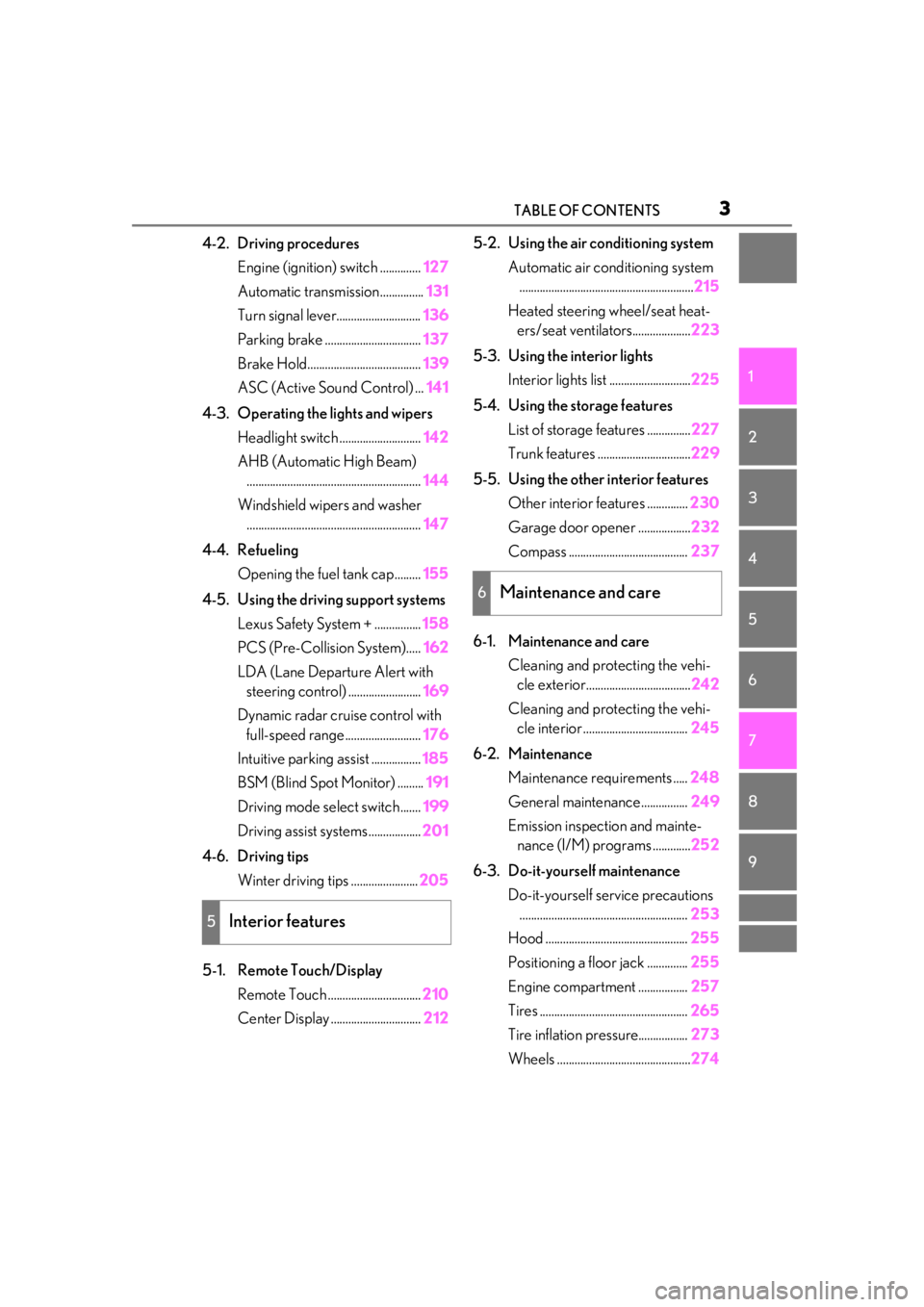
3TABLE OF CONTENTS
1
2
3
4
5
6
7
8
9
4-2. Driving proceduresEngine (ignition) switch .............. 127
Automatic transmission............... 131
Turn signal lever............................. 136
Parking brake ................................. 137
Brake Hold....................................... 139
ASC (Active Sound Control) ... 141
4-3. Operating the lights and wipers Headlight switch ............................ 142
AHB (Automatic High Beam) ............................................................ 144
Windshield wipers and washer ............................................................ 147
4-4. Refueling Opening the fuel tank cap......... 155
4-5. Using the driving support systems Lexus Safety System + ................ 158
PCS (Pre-Collision System)..... 162
LDA (Lane Departure Alert with steering control) ......................... 169
Dynamic radar crui se control with
full-speed range.......................... 176
Intuitive parking assist ................. 185
BSM (Blind Spot Monitor) ......... 191
Driving mode select switch....... 199
Driving assist systems .................. 201
4-6. Driving tips Winter driving tips ....................... 205
5-1. Remote Touch/Display Remote Touch ................................ 210
Center Display ............................... 2125-2. Using the air conditioning system
Automatic air conditioning system............................................................ 215
Heated steering wheel/seat heat- ers/seat ventilators.................... 223
5-3. Using the interior lights Interior lights list ............................ 225
5-4. Using the storage features List of storage features ............... 227
Trunk features ................................ 229
5-5. Using the other interior features Other interior features .............. 230
Garage door opener .................. 232
Compass ......................................... 237
6-1. Maintenance and care Cleaning and protecting the vehi-cle exterior.................................... 242
Cleaning and protecting the vehi- cle interior .................................... 245
6-2. Maintenance Maintenance re quirements .....248
General maintenance................ 249
Emission inspection and mainte- nance (I/M) programs ............. 252
6-3. Do-it-yourself maintenance Do-it-yourself service precautions.......................................................... 253
Hood ................................................. 255
Positioning a floor jack .............. 255
Engine compartment ................. 257
Tires ...
................................................ 265
Tire inflation pressure................. 273
Wheels .............................................. 274
5Interior features
6Maintenance and care
Page 4 of 400
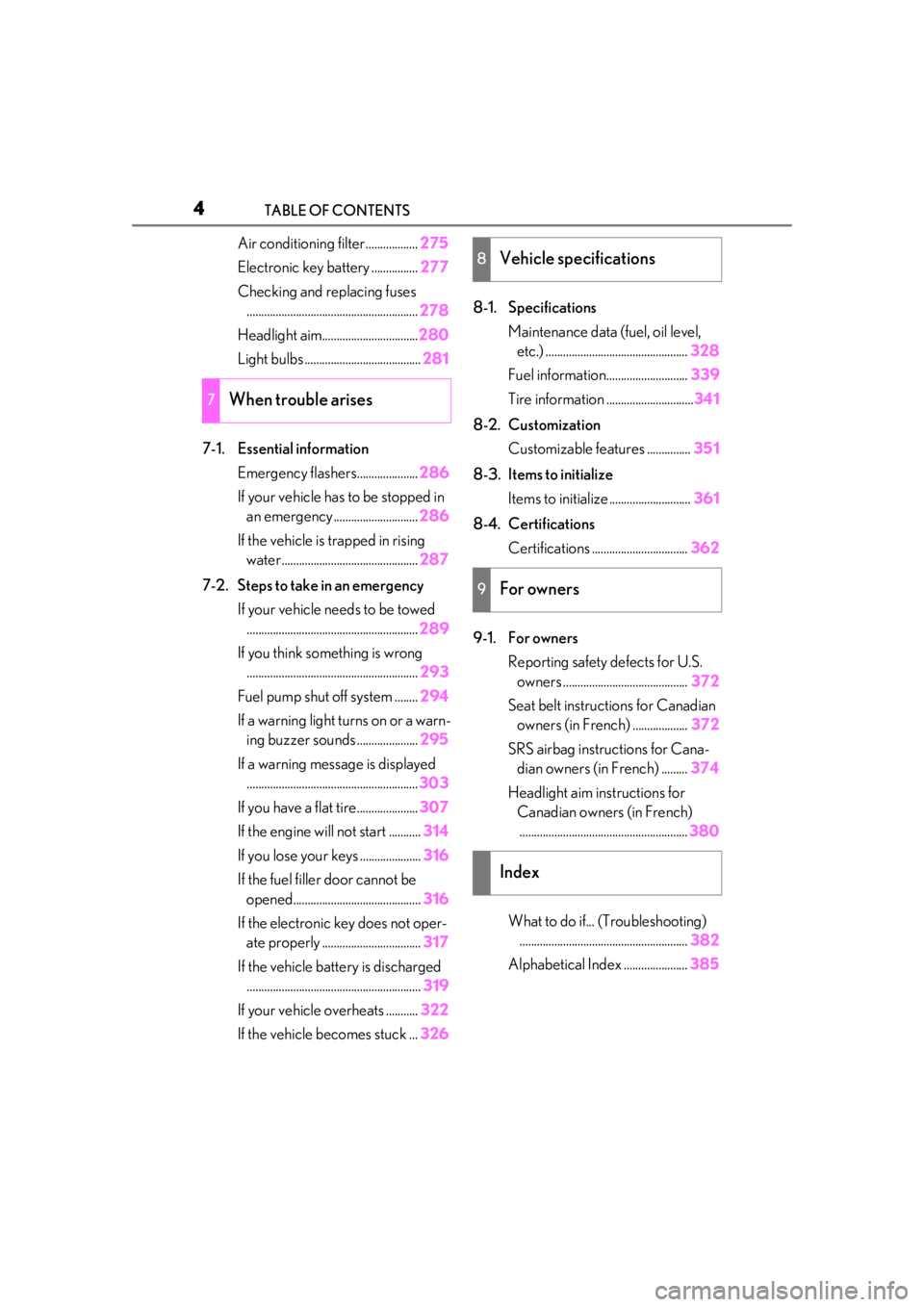
4TABLE OF CONTENTS
Air conditioning filter..................275
Electronic key battery ................ 277
Checking and replacing fuses ........................................................... 278
Headlight aim................................. 280
Light bulbs ........................................ 281
7-1. Essential information Emergency flashers..................... 286
If your vehicle has to be stopped in an emergency ............................. 286
If the vehicle is trapped in rising water............................................... 287
7-2. Steps to take in an emergency If your vehicle needs to be towed........................................................... 289
If you think something is wrong ........................................................... 293
Fuel pump shut off system ........ 294
If a warning light turns on or a warn- ing buzzer sounds ..................... 295
If a warning message is displayed ........................................................... 303
If you have a flat tire..................... 307
If the engine wi ll not start ........... 314
If you lose your keys ..................... 316
If the fuel filler door cannot be opened............................................ 316
If the electronic key does not oper- ate properly .................................. 317
If the vehicle battery is discharged ............................................................ 319
If your vehicle overheats ........... 322
If the vehicle becomes stuck ... 3268-1. Specifications
Maintenance data (fuel, oil level, etc.) ................................................. 328
Fuel information............................ 339
Tire information .............................. 341
8-2. Customization Customizable features ............... 351
8-3. Items to initialize Items to initialize ............................ 361
8-4. Certifications Certifications ................................. 362
9-1. For owners Reporting safety defects for U.S. owners ........................................... 372
Seat belt instructions for Canadian owners (in French) ................... 372
SRS airbag instructions for Cana- dian owners (in French) ......... 374
Headlight aim instructions for Canadian owners (in French).......................................................... 380
What to do if... (Troubleshooting) .......................................................... 382
Alphabetical Index ...................... 385
7When trouble arises
8Vehicle specifications
9For owners
Index
Page 14 of 400

14Pictorial index
Parking brake switch ............................................................................................. P.137
Applying/releasing ............................................................................................................P.137
Precautions for winter season .. ................................................................................... P.206
Warning buzzer/message............................................................................................P.303
Headlight switch ..................................................................................................... P.142
Turn signal lever ...................................................................................................... P.136
Headlights/parking lights/tail lights/license plate lig hts/daytime running lights
....................................................................................................................................................P.142
Windshield wiper and washer switch ................................................................ P.147
Usage.......................................................................................................................... .............P.147
Adding washer fluid ......................................................................................................... P.2 64
Warning messages ..........................................................................................................P.303
Headlight cleaners
*1..........................................................................................................P.147
Emergency flasher switch ...................................................................................P.286
Trunk opener switch.................................................................................................P.92
Hood lock release lever .......................................................................................P.255
Tilt and telescopic steering control switch
*1.................................................. P.108
Adjustment ..................................................................................................................... ...... P.108
Driving position memory
*1............................................................................................. P.102
Tilt and telescopic steeri ng lock release lever
*1........................................... P.108
Adjustment ..................................................................................................................... ...... P.108
Air conditioning system ........................................................................................ P.215
Usage.......................................................................................................................... ............ P.215
Rear window defogger.....................................................................................................P.219
Audio system
*2
Trunk opener main switch ......................................................................................P.94
*1: If equipped
*2: Refer to “NAVIGATION AND MULTIMEDIA SYSTEM OWNER’S MANUAL”.
E
F
G
H
I
J
K
L
M
N
O
Page 30 of 400

301-1. For safe use
severity and occupant information. As the airbags deploy, a chemical reaction in
the inflators quickly fills the airbags with non-toxic gas to help restrain the motion of
the occupants.
■If the SRS airbags deploy (inflate)
●Slight abrasions, burns, bruising etc., may
be sustained from SRS airbags, due to the
extremely high speed deployment (infla-
tion) by hot gases.
●A loud noise and white powder will be
emitted.
●Parts of the airbag module (steering
wheel hub, airbag cover and inflator) as
well as the front seat s, parts of the front
and rear pillars, and roof side rails, may
be hot for several minutes. The airbag
itself may also be hot.
●The windshield may crack.
●All of the doors will be unlocked.
( P.89)
●Fuel supply to the engine will be stopped.
( P.294)
●For Lexus Enform Safety Connect sub-
scribers, if any of the following situations
occur, the system is designed to send an
emergency call to the response center,
notifying them of the vehicle’s location
(without needing to push the “SOS” but-
ton) and an agent will attempt to speak
with the occupants to ascertain the level
of emergency and assi stance required. If
the occupants are unable to communi-
cate, the agent automatically treats the
call as an emergency and helps to dis-
patch the necessary emergency services.
( P.52)
• An SRS airbag is deployed.
• A seat belt pretensioner is activated.
• The vehicle is involved in a sever rear-end collision.
■SRS airbag deployment conditions (SRS
front airbags)
●The SRS front airbags will deploy in the
event of an impact that exceeds the set
threshold level (the level of force corre-
sponding to an approximately 12 - 18
mph [20 - 30 km/h] frontal collision with
a fixed wall that does not move or
deform). However, this threshol
d velocity will be
considerably higher in the following situa-
tions:
• If the vehicle strikes an object, such as a parked vehicle or sign pole, which can
move or deform on impact
• If the vehicle is involved in an underride
collision, such as a collision in which the
front of the vehicle “underrides”, or goes
under, the bed of a truck
●Depending on the type of collision, it is
possible that only the seat belt preten-
sioners will activate.
●The SRS front airbags for the front pas-
senger will not activate if there is no pas-
senger sitting in the front passenger seat.
However, the SRS front airbags for the
front passenger may deploy if luggage is
put in the seat, even if the seat is unoccu-
pied.
■SRS airbag deployment conditions (SRS
side and curtain shield airbags)
●The SRS side and curtain shield airbags
will deploy in the event of an impact that
exceeds the set threshold level (the level
of force corresponding to the impact
force produced by an approximately
3300 lb. [1500 kg] vehicle colliding with
the vehicle cabin from a direction per-
pendicular to the vehicle orientation at an
approximate speed of 12 - 18 mph [20 -
30 km/h]).
●Both SRS curtain shield airbags will
deploy in the event of vehicle rollover.
●All SRS side and curtain shield airbags
will deploy in the event of a severe frontal
collision.
■Conditions under which the SRS air-
bags may deploy (inflate), other than a
collision
The SRS front airbags and SRS side and
curtain shield airbags may also deploy if a
serious impact occurs to the underside of
your vehicle. Some examples are shown in
the illustration.
●Hitting a curb, edge of pavement or hard
Page 36 of 400
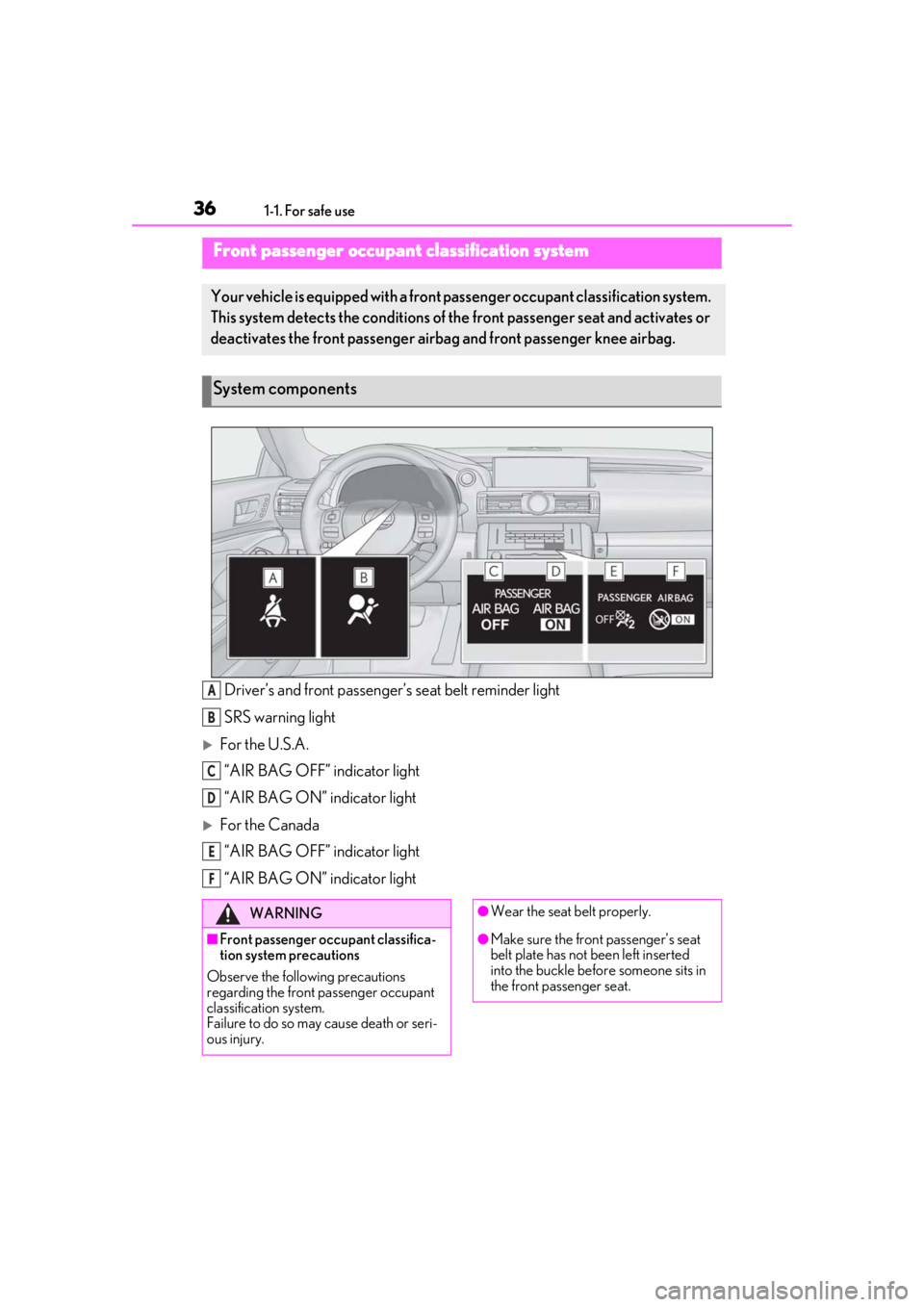
361-1. For safe use
Driver’s and front passenger’s seat belt reminder light
SRS warning light
For the U.S.A. “AIR BAG OFF” indicator light
“AIR BAG ON” indicator light
For the Canada“AIR BAG OFF” indicator light
“AIR BAG ON” indicator light
Front passenger occupant classification system
Your vehicle is equipped with a front pa ssenger occupant classification system.
This system detects the conditions of th e front passenger seat and activates or
deactivates the front passenger airb ag and front passenger knee airbag.
System components
A
B
C
D
E
F
WARNING
■Front passenger occupant classifica-
tion system precautions
Observe the following precautions
regarding the front passenger occupant
classification system.
Failure to do so may cause death or seri-
ous injury.
●Wear the seat belt properly.
●Make sure the front passenger’s seat
belt plate has not been left inserted
into the buckle before someone sits in
the front passenger seat.
Page 38 of 400
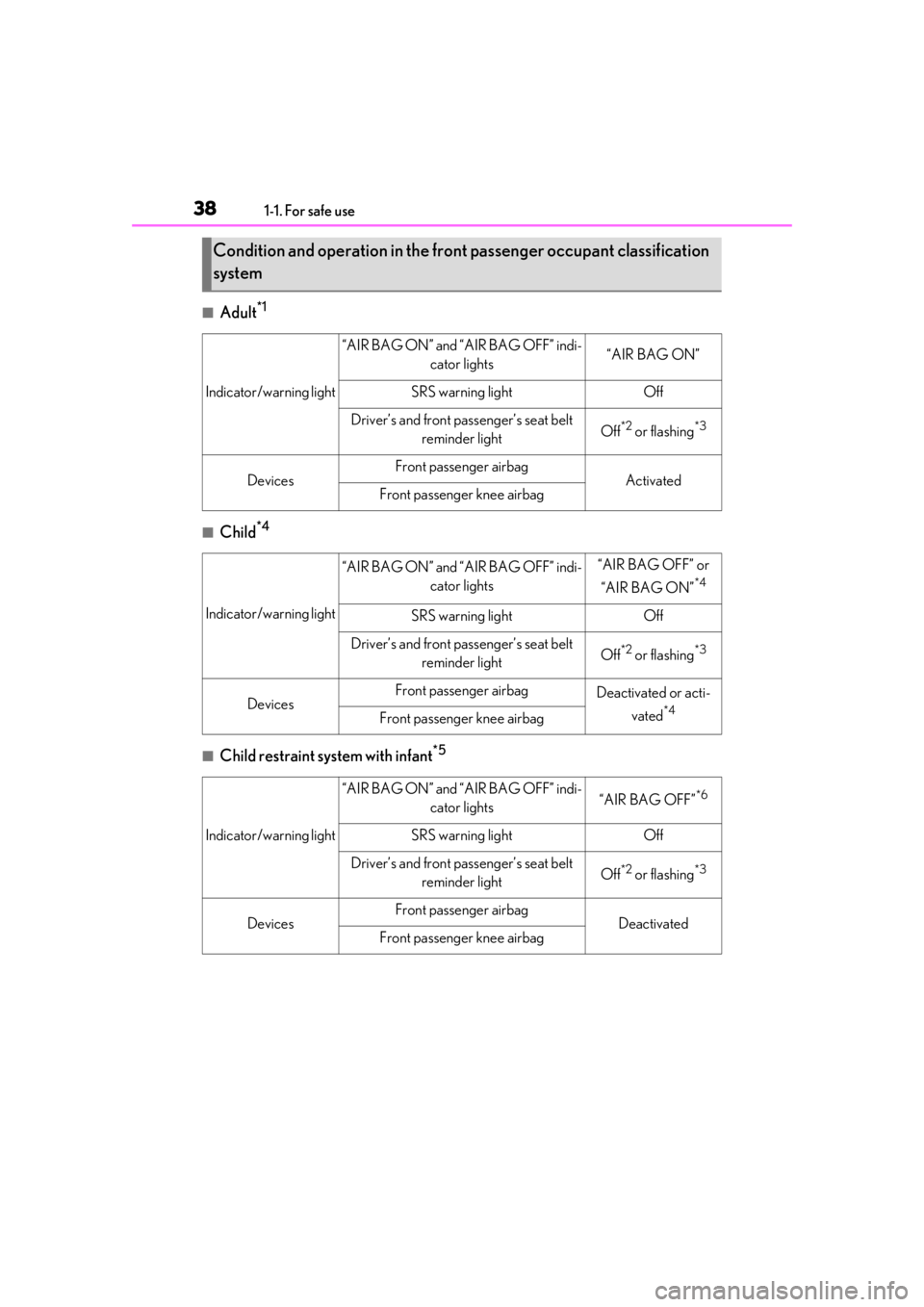
381-1. For safe use
■Adult*1
■Child*4
■Child restraint system with infant*5
Condition and operation in the front passenger occupant classification
system
Indicator/warning light
“AIR BAG ON” and “AIR BAG OFF” indi-cator lights“AIR BAG ON”
SRS warning lightOff
Driver’s and front passenger’s seat belt reminder lightOff*2 or flashing*3
DevicesFront passenger airbagActivatedFront passenger knee airbag
Indicator/warning light
“AIR BAG ON” and “AIR BAG OFF” indi- cator lights“AIR BAG OFF” or
“AIR BAG ON”
*4
SRS warning lightOff
Driver’s and front passenger’s seat belt reminder lightOff*2 or flashing*3
DevicesFront passenger airbagDeactivated or acti-
vated
*4Front passenger knee airbag
Indicator/warning light
“AIR BAG ON” and “AIR BAG OFF” indi- cator lights“AIR BAG OFF”*6
SRS warning lightOff
Driver’s and front passenger’s seat belt reminder lightOff*2 or flashing*3
DevicesFront passenger airbagDeactivatedFront passenger knee airbag
Page 54 of 400
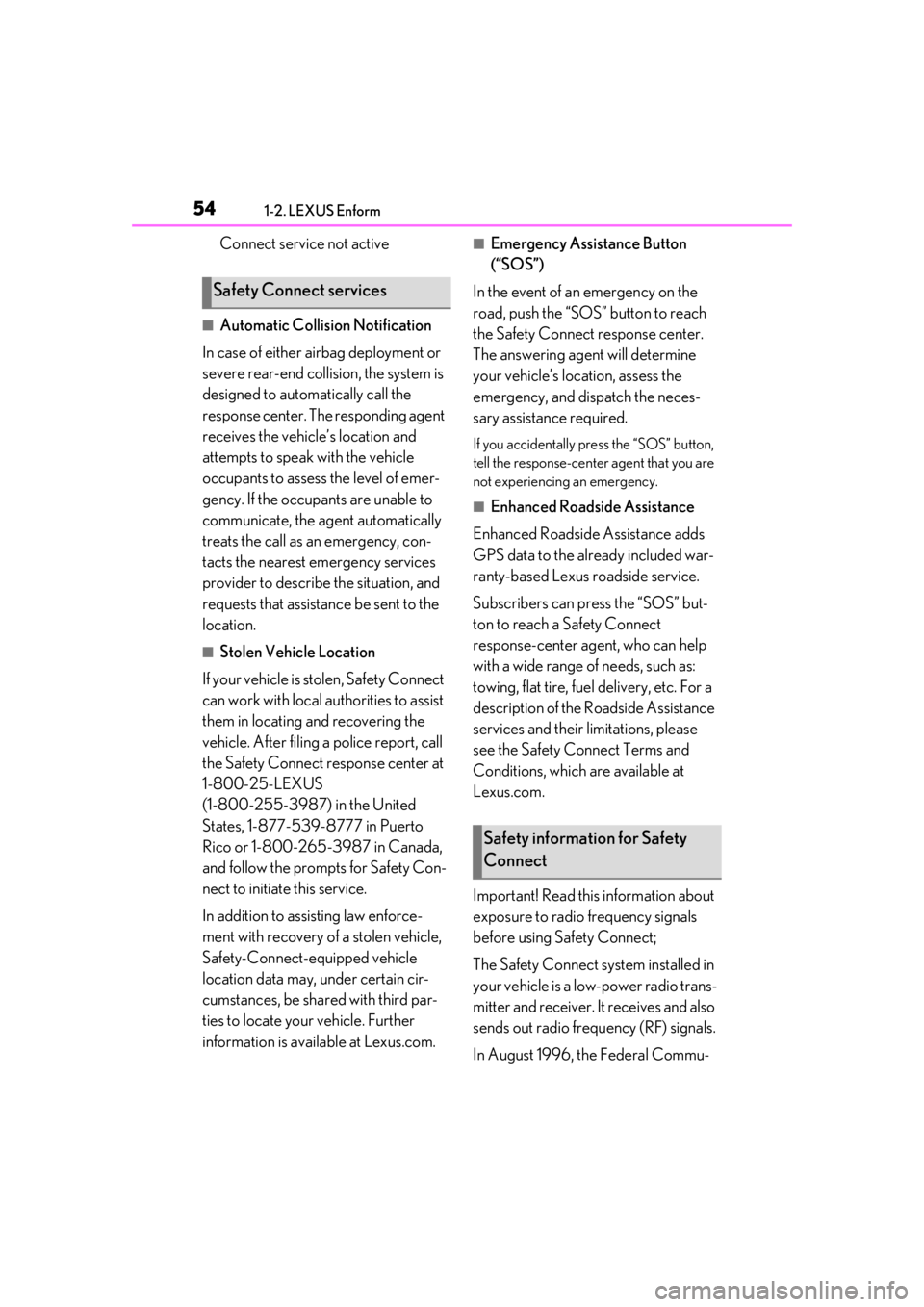
541-2. LEXUS Enform
Connect service not active
■Automatic Collision Notification
In case of either airbag deployment or
severe rear-end collision, the system is
designed to automatically call the
response center. The responding agent
receives the vehicle’s location and
attempts to speak with the vehicle
occupants to assess the level of emer-
gency. If the occupants are unable to
communicate, the ag ent automatically
treats the call as an emergency, con-
tacts the nearest emergency services
provider to describe the situation, and
requests that assistance be sent to the
location.
■Stolen Vehicle Location
If your vehicle is stolen, Safety Connect
can work with local authorities to assist
them in locating and recovering the
vehicle. After filing a police report, call
the Safety Connect response center at
1-800-25-LEXUS
(1-800-255-3987) in the United
States, 1-877-539-8777 in Puerto
Rico or 1-800-265- 3987 in Canada,
and follow the prompts for Safety Con-
nect to initiate this service.
In addition to assisting law enforce-
ment with recovery of a stolen vehicle,
Safety-Connect-equipped vehicle
location data may, under certain cir-
cumstances, be shared with third par-
ties to locate your vehicle. Further
information is available at Lexus.com.
■Emergency Assistance Button
(“SOS”)
In the event of an emergency on the
road, push the “SOS” button to reach
the Safety Connect response center.
The answering agent will determine
your vehicle’s location, assess the
emergency, and dispatch the neces-
sary assistance required.
If you accidentally press the “SOS” button,
tell the response-center agent that you are
not experiencing an emergency.
■Enhanced Roadside Assistance
Enhanced Roadside Assistance adds
GPS data to the already included war-
ranty-based Lexus roadside service.
Subscribers can press the “SOS” but-
ton to reach a Safety Connect
response-center agent, who can help
with a wide range of needs, such as:
towing, flat tire, fuel delivery, etc. For a
description of the Roadside Assistance
services and their limitations, please
see the Safety Connect Terms and
Conditions, which are available at
Lexus.com.
Important! Read this information about
exposure to radio frequency signals
before using Safety Connect;
The Safety Connect system installed in
your vehicle is a low-power radio trans-
mitter and receiver. It receives and also
sends out radio frequency (RF) signals.
In August 1996, the Federal Commu-
Safety Connect services
Safety information for Safety
Connect
Page 96 of 400

963-2. Opening, closing and locking the doors and trunk
●When an interior alarm sounds continu-
ously
■Battery-saving function
The battery-saving fu nction will be acti-
vated in order to prevent the electronic key
battery and the vehicle battery from being
discharged while the vehicle is not in opera-
tion for a long time.
●In the following situations, the smart
access system with pu sh-button start may
take some time to unlock the doors.
• The electronic key has been left within approximately 6 ft. (2 m) of the outside of
the vehicle for 10 minutes or longer.
• The smart access system with push-but- ton start has not been used for 5 days or
longer.
●If the smart access system with push-but-
ton start has not been used for 14 days or longer, the doors cann
ot be unlocked at
the passenger door. In this case, take hold
of the driver’s door handle, or use the
wireless remote control or mechanical
key, to unlock the doors.
■Electronic Key Battery-Saving Function
When battery-saving mode is set, battery
depletion is minimized by stopping the elec-
tronic key from receiving radio waves.
Press twice while pressing and holding
. Confirm that the electronic key indica-
tor flashes 4 times.
While the battery-saving mode is set, the
smart access system with push-button start
cannot be used. To cancel the function,
press any of the electronic key buttons.
■Conditions affecting operation
The smart access system with push-button
start uses weak radio waves. In the following
situations, the communication between the
electronic key and the vehicle may be
affected, preventing the smart access sys-
tem with push-button start, wireless remote
control and engine immobilizer system
from operating properly.
(Ways of coping: P.317)
●When the electronic key battery is
depleted
●Near a TV tower, electric power plant,
gas station, radio stat ion, large display,
airport or other fac ility that generates
strong radio waves or electrical noise
●When carrying a portable radio, cellular
phone, cordless phone or other wireless
communication device
●When the electronic key is in contact
with, or is covered by the following metal-
lic objects
• Cards to which aluminum foil is attached
SituationCorrection
procedure
The trunk was closed
while the electronic key
was still inside the trunk
and both side doors were
locked.Retrieve the
electronic key
from the trunk
and close the
trunk lid.
An attempt was made to
lock the vehicle while a
door was open.Close both
side doors and
lock the doors
again.
SituationCorrection procedure
The engine switch was
turned to ACCESSORY
mode while the driver’s
door was open (or the
driver’s door was opened
while the engine switch
was in ACCESSORY
mode).
Turn the engine
switch off and
close the
driver’s door.
The engine switch was
turned off while the
driver’s door was open.Close the
driver’s door.
Page 161 of 400
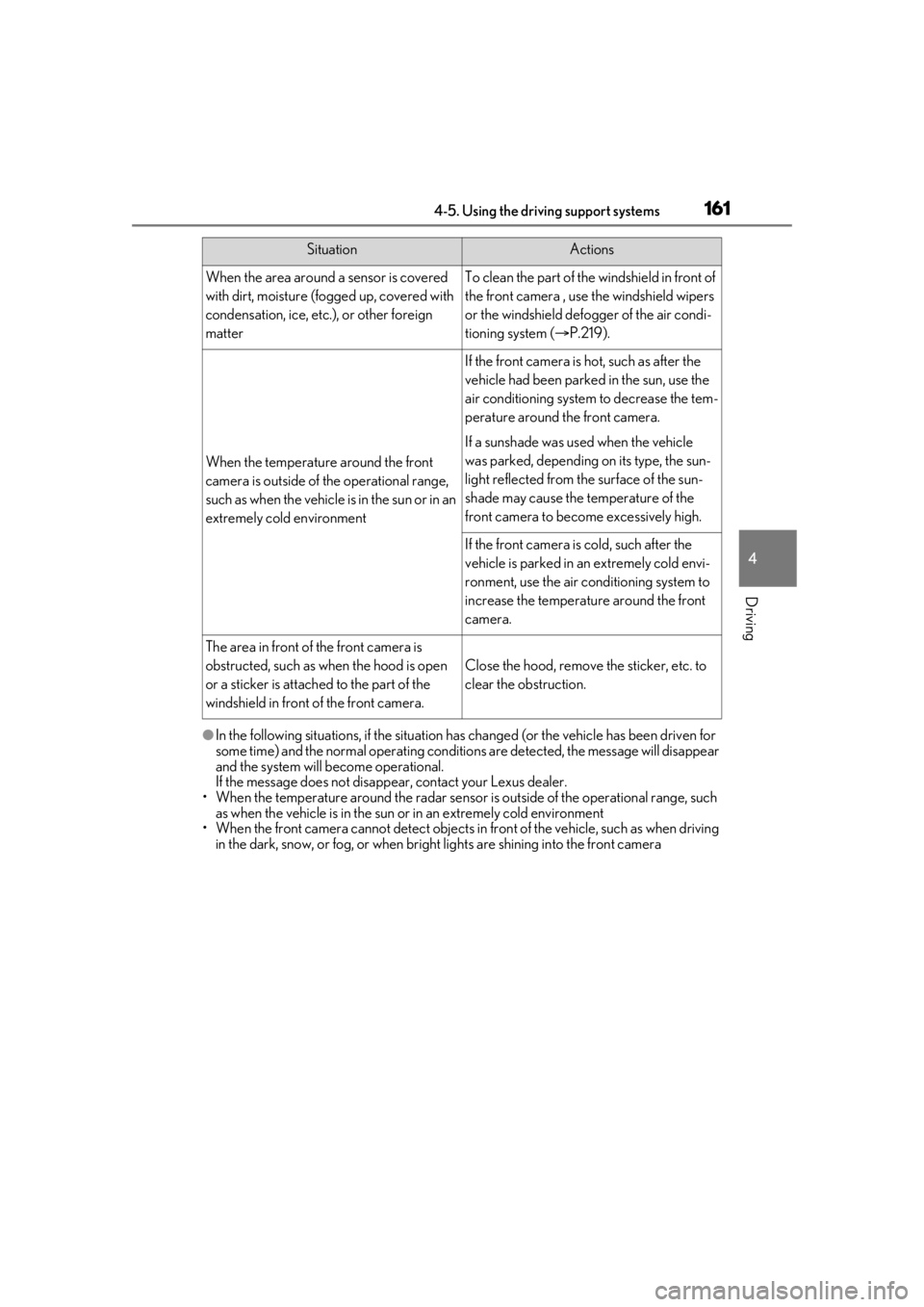
1614-5. Using the driving support systems
4
Driving
●In the following situations, if the situation has changed (or the vehicle has been driven for
some time) and the normal operating conditions are detected, the message will disappear
and the system will become operational.
If the message does not disappear, contact your Lexus dealer.
• When the temperature around the radar sensor is outside of the operational range, such as when the vehicle is in the sun or in an extremely cold environment
• When the front camera cannot detect objects in front of the vehicle, such as when driving
in the dark, snow, or fog, or when brig ht lights are shining into the front camera
SituationActions
When the area around a sensor is covered
with dirt, moisture (f ogged up, covered with
condensation, ice, etc.), or other foreign
matterTo clean the part of the windshield in front of
the front camera , use the windshield wipers
or the windshield defo gger of the air condi-
tioning system ( P.219).
When the temperature around the front
camera is outside of the operational range,
such as when the vehicle is in the sun or in an
extremely cold environment
If the front camera is hot, such as after the
vehicle had been parked in the sun, use the
air conditioning system to decrease the tem-
perature around the front camera.
If a sunshade was used when the vehicle
was parked, depending on its type, the sun-
light reflected from the surface of the sun-
shade may cause the temperature of the
front camera to become excessively high.
If the front camera is cold, such after the
vehicle is parked in an extremely cold envi-
ronment, use the air conditioning system to
increase the temperature around the front
camera.
The area in front of the front camera is
obstructed, such as when the hood is open
or a sticker is attached to the part of the
windshield in front of the front camera.
Close the hood, remove the sticker, etc. to
clear the obstruction.